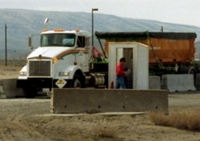May 13, 2005The environmental restoration (ER) team of Bechtel Hanford transports and secures radioactive debris at the Hanford Nuclear Site, a 586-square-mile former plutonium production facility that stretches along the Columbia River in southeastern Washington. The company recently deployed an active RFID system to automatically identify the trucks and containers used to transport the waste. And in doing so it eliminated the last manual step in its waste management tracking system.
The 700-member ER team, which is operated by Bechtel, a San Francisco-based global engineering and construction firm, through a contract with the Department of Energy, extracts waste materials along a nearly 200-square-mile corridor of the Columbia River and transports them to a central landfill on the Hanford site. It moves an average of 200 truckloads, carrying a total of 4,000 tons per day.
To move the loads, the ER team uses large steel containers, called cans, that attach to trucks. In total, it maintains a fleet of approximately 20 trucks and 200 cans. It is important that the ER team determine the accurate weight of each load of waste it brings to the landfill in order to keep track of the quantities of the materials being transported. This is the main reason Bechtel Hanford deployed RFID to track its trucks. This RFID data is used in combination with a bar code-based system that tracks the kinds of materials being placed in permanent storage and how they must be handled with respect to levels of hazard those pose.
Prior to the RFID deployment, which was launched last week, operators had to key in the identification number of the truck and the identification number of the can for each load as it sat on a large industrial scale. The scale then used the ID numbers to call up the weight of the truck and the can when empty from an Oracle database. It determines the net weight of the load by subtracting the weight of the truck and empty can from the gross weight.
Now, active tags from AXCESS attached to the trucks and cans transmit these ID numbers to a reader that is linked, through a serial connection, to the scale. This saves the operator from having to key in the ID and avoids any inaccurate load weights that could results from keying in incorrect IDs.
The active tags are designed by AXCESS, using a Texas Instruments microprocessor. They have a range of approximately 100 feet and operate at 315 MHz. As the trucks approach the weigh station, an activator excites the tags attached to the truck and can, using a 126 kHz signal. With the tags now transmitting, antennas placed around the scale transmit the signals to AXCESS reader, which sends the tag data to the scale. All of the AXCESS hardware is designed by AXCESS and manufactured through contractors.
Steve Teller, an IT manager with Bechtel Automation Technology, directed the RFID deployment. He and his team began attaching the tags to the trucks and cans, installed the activator, reader and its antennas in January of this year. The most difficult part, he says, was determining the optimal placement of the tags on the cans. "We use cans with four different designs. If you look at them, you wouldn't think the designs are very different, but those little differences become big differences when you're using RFID, because the radio waves are bouncing off everything," he says.
After Teller and his team optimized the placement of the tags, he called a team of AXCESS technicians out to Hanford to help optimize the functionality of the antennas. Turns out the receiving antenna was missing a grounding plate. With that in place, the AXCESS system is now operating at 95 to 98 percent successful read rate.
Members of the ER team keep track the makeup of the waste materials, including levels of radionuclides, in each load, as well as the exact location from which it was taken, by inputting that data into a program that prints the waste profile of each load on bar coded paperwork, which the truck operators carry with each load. After the truck and can have been identified and weighed, the operators scan the bar code on the paperwork associated with the load using a scanner link to the scale. A computer monitor at the scale guides them through the process and alerts them to whether the RFID tags have been successfully read (if they are not read, the truck and can IDs are keyed into the scale). A software application, written by Teller's team with the help of the scale manufacturer, Cardinal, integrates the bar code and RFID data into the Oracle database. It is important to know the types of waste that each can carries so that operators can clean the can appropriately before using it to haul another load.
As each load is placed in the landfill, operators using handheld computers scan the bar code on the paperwork one last time. At the end of each day, the data on the handheld is downloaded into the main database to produce a complete record, "from cradle-to-grave," of each load of waste, says Teller.
Because Hanford does not send any of its waste materials to other sites or accept waste from other nuclear facilities, the AXCESS deployment will remain a closed-loop system for the foreseeable future. However, Bechtel does operate other remediation contracts at other nuclear facilities, and Teller says there could be applications for similar deployments at those sites in the future.
He says he's pleased with the overall performance and durability of the AXCESS readers and tags and that he picked AXCESS out of a number of other active RFID providers because its products had been deploy for vehicle ID in a range of industries. "There were other companies that had a lot of experience in single industries," says Teller. "I wanted a company that had a lot of different kinds of experience deploying RFID in the field."


